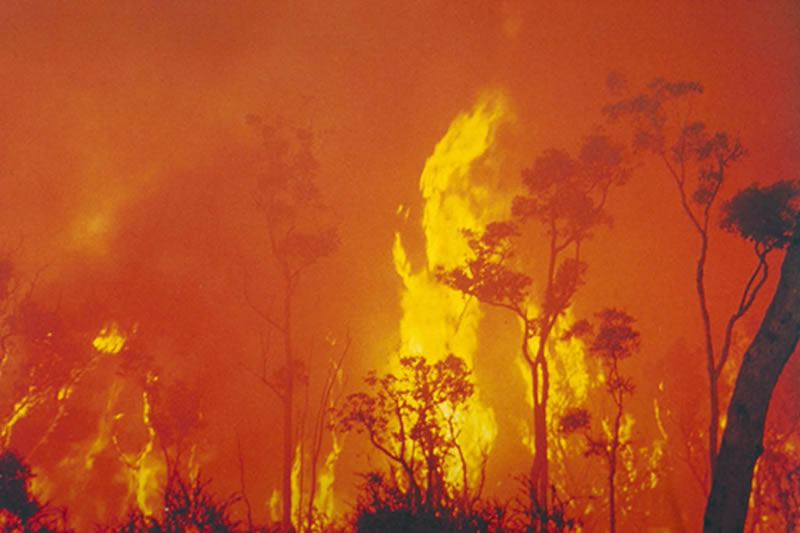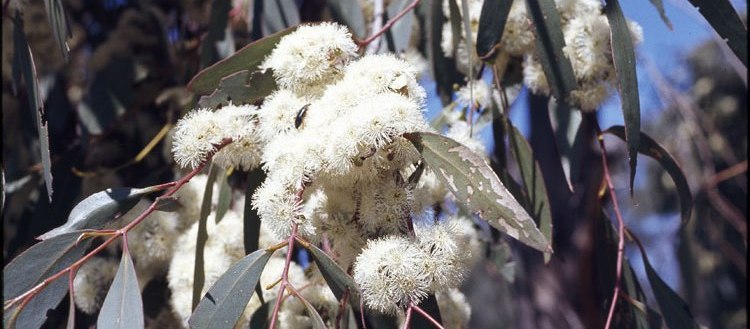Adaptations
Eucalyptus trees are known to be some
of the hardiest, most adaptive plant species on Earth, allowing
them to thrive under a variety of terrain, soil, moisture, and
ecological conditions.
Millions of years ago, rainforests covered a much greater
portion of the Australian continent than at the present, and the
ancestral precursors to eucalypts likely inhabited the outer
fringes of these rainforests because of their adaptability to
drier, less enriched soils.
When the drying effects of
 climate change eventually
caused Australia’s moist, green canopies to retreat, the early
Eucalyptus species
were well-prepared to adapt and become the dominant forest
vegetation. Today,
the rainforests of the island continent are like islands
themselves, relatively small pockets of dense, green canopy
surrounded by more open eucalypt woodlands.
climate change eventually
caused Australia’s moist, green canopies to retreat, the early
Eucalyptus species
were well-prepared to adapt and become the dominant forest
vegetation. Today,
the rainforests of the island continent are like islands
themselves, relatively small pockets of dense, green canopy
surrounded by more open eucalypt woodlands.
The most vital survival tool of
most modern Eucalyptus
species is their cooperation with the cyclical
fire patterns that punctuate
life in the Australian ecosysytems.
As the climate became more arid over the millennia, the warm
air coupled with abundant dry plant matter created ideal conditions
for frequent thunderstorms and subsequent forest fires.
Species in the
Eucalyptus genus possess a number of adaptations which allow
them to survive these blazes, including thick, tough bark to protect
the vulnerable heartwood layers beneath.
Concealed under this natural armor, many
Eucalyptus species have a
reserve of leaf buds; astoundingly, the extreme heat of the fire
activates chemical reactions in these buds, causing a new set of
leaves to grow after the fire.
In fact, the leaves themselves are characteristically rich in
oil (read more about eucalyptus oil on the
Interactions page), which causes them to burn intensely but very rapidly;
not only does this protect the inner heartwood tissue from prolonged
heat exposure, it also increases the fire’s ability to spread to
other trees. This is
especially important for reproduction in some species of
Eucalyptus, such as
E. regnans, whose seeds will only germinate after a fire has swept the ground.
which causes them to burn intensely but very rapidly;
not only does this protect the inner heartwood tissue from prolonged
heat exposure, it also increases the fire’s ability to spread to
other trees. This is
especially important for reproduction in some species of
Eucalyptus, such as
E. regnans, whose seeds will only germinate after a fire has swept the ground.
Additional adaptations found in
this genus include a rapid growth rate, as is seen in
E. gunii, an ornamentally
cultivated tree common in Great Britain that can grow up to 1.5
meters in a single year.
Eucalyptus trees are
evergreen, and their leaves typically hang vertically to avoid the
desiccating effects of the Australian sun.
The leaves are also covered with a waxy surface to help keep some
types of
 herbivorous beetles from getting a foothold, and the oils
in the leaves are toxic to many predators (with a well-known
exception being Phascolarctos
cinereus, the koala).
herbivorous beetles from getting a foothold, and the oils
in the leaves are toxic to many predators (with a well-known
exception being Phascolarctos
cinereus, the koala).
This arsenal of survival tools led
to the adaptive radiation of the ancestral eucalypts into the more
than seven hundred Eucalyptus
species known today.
In their native Australia, eucalypts occupy diverse habitats, such
as the snow gum trees that grow in the alpine regions, or the
brightly flowering species that spring up in forests near streams.
Their readiness to adapt destined the
Eucalyptus trees for
travel, and over two hundred species have been artificially
introduced to other parts of the world, including California in the
nineteenth century, as well as East Africa, Sri Lanka, and Portugal.
